We’ve all been through the experience of staring at the rows and rows of wines in the shop, and wandering, “which one should I buy?” Although wine labels can be beautifully designed with exquisite calligraphy or enchanting pictures, the information on the label can help you to choose the perfect bottle or have you place it back on the shelf.
The first thing to note is the difference between Old World wines and New World wines. Old World wines are wine growing regions traditionally in Europe, while New World wines refer to all other countries such as USA, Australia, South Africa etc.
Here are some tips on reading a wine label:
- Variety or Appellation – The region will tell you what type of grapes were used in the wine. This really applies to Old World wines, because the bottle will never indicate the grape varietal. For example, Chablis will never write Chardonnay on the bottle – Chardonnay being the grape variety. The same concept applies for Bordeaux. Any wine produced in this region will be able to write “Bordeaux” on the bottle, and if you don’t know what grapes are grown in Bordeaux, you’ll never know what’s in the bottle! Most common grapes grown in Bordeaux are Cabernet Sauvignon, Cabernet Franc and Merlot. New World wines however, almost always indicate the grape variety on the bottle, stating “Sauvignon Blanc”, “Moscato”, etc. In addition, it will still always state where the wine was produced.
- Region – Generally, wines that are produced in larger vineyards are usually “value wines”, as opposed to wines from very small or specific vineyards typically indicate that the wine is of higher quality. Therefore, the price varies between the two. For example, if a bottle of wine simply states “California”, compared to a wine that states “Napa Valley”, the Napa Valley wine will almost always be more refined and cost more.
- Alcohol level – Wines vary in alcohol, and this percentage is always written on the label. Although it doesn’t seem like it may affect the wine, the ABV (alcohol by volume) actually says a lot about the wine, as it can give an idea as to how rich, concentrated, big, or heavy the wine may taste. Wines that have a higher ABV are usually made from riper grapes (more sugar that turns into alcohol).
There are many other aspects on the label that can affect your decision. In countries such as Spain and Italy, there are additional rules that are followed. For example, in Spain, “Reserva” or “Gran Reserva” can sometimes be seen on red wine bottles. This is because Spain follows a concept of “aging the wine for you”. This means, the wine is aged (either in the bottle or the barrel, or both) and stored at the producer’s vineyard. It is not released for distribution until the wine has reached its perfect flavor point. Reserva wines are not released until they’ve been aged for a minimum of 3 years, with at least one year in the cask. Gran Reserva wines have been aged for at least 2 years in the barrel and another 3 years in the bottle.
With time, practice, and lots of trial and error – picking a wine that you believe will suit your taste can become fun and easier. The most important thing however, is to familiarize yourself with major wine producing regions and grape varietals, so you can understand what you’re reading – and always have an open mind!
Get in touch here or at hello@coralrange.com.
